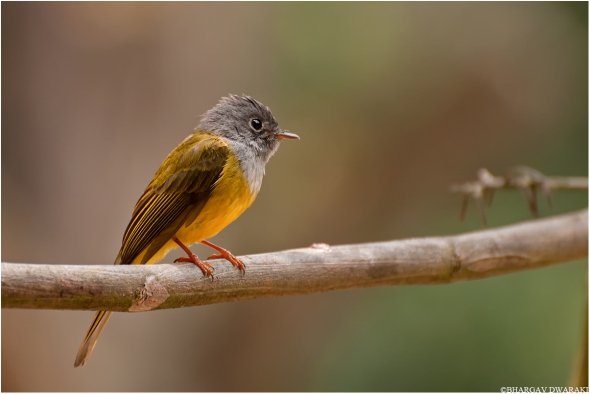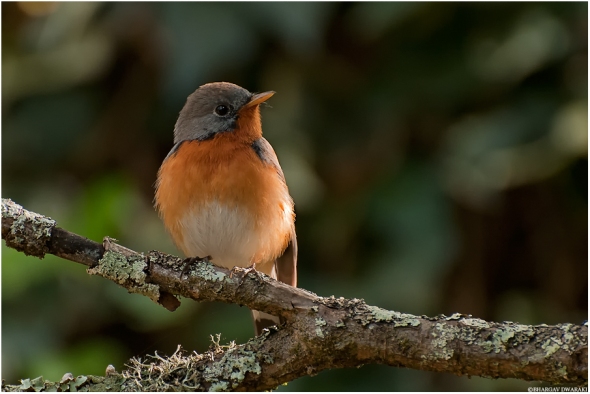Grey -headed Canary -flycatcher(Culicicapa ceylonensis)
The Grey headed Canary flycatcher (Culicicapa ceylonensis) is an insectivorous and a species of small flycatcher – like bird found in tropical Asia.
This species breeds in upland to montane oak and other broadleaved forests and similar wooded areas in temperate to tropical southern Asia, from Pakistan, Central India and Sri Lanka east to Indonesia and southern China. Many populations are resident, but some Himalayan birds are partial migrants that winter in Peninsular India sometimes even occurring in arid habitats.
The Grey-headed Canary-flycatcher is about 10 cm long with a squarish grey head, a canary yellow belly and yellowish-green upperparts. They forage actively like flycatchers and perches in a very upright posture. The sexes are indistinguishable in plumage. They have a very flat bill which when seen from above look like an equilateral triangle and is fringed with long rictal bristles.
The Grey-headed Canary-flycatcher is an insectivore and like flycatchers makes sallies for aerial insects from a low perch under the canopy of a tree. A pair may forage together and they will often join mixed -species foraging flocks.( Source – Wikipedia)
As we(myself and Vinod ) reached Ooty, we made a list of species that were special from this region .We wanted to spot and photograph each of them.Apart from the commoners like Mynas and Sparrows ,the first bird which we saw was this little Grey headed Canary-flycatcher. Though we spotted it quite easily and spent close to two hours ,I could not make a descent picture as it used to sit up high in trees or on the grills.Next day morning too went with out much luck (in terms of Photography), later in the day I saw it perch on a branch with less or no clutter .I went there and I was waiting for it to come back ( yes,these birds do perch on the same place), initially I missed few shots but this bird had kind of got used me and gave an other opportunity. Light was little harsh but I will take it!.Hope you like it 🙂
Have a great Day 🙂
Cheers,
Bhargav
Kashmir Flycatcher (Ficedula subrubra)
The Kashmir Flycatcher(Ficedula subrubra) is a small passerine bird in the flycatcher family Muscicapidae.
This is an insectivorous species which breeds in the north-west Himalayas in the Kashmir region. It is migratory and winters in the Western Ghats and in the hills of central Sri Lanka.
It is 13 cm long.The male has a grey-brown back with an orange-red throat, breast and flanks, bordered with black on the throat and breast. Females and first-winter birds have slightly browner upper parts, and the red of the underparts reduced to just a pinkish wash.
The Kashmir Flycatcher breeds in deciduous forest with dense undergrowth, nesting in a hole in a tree and laying 3-5 eggs which are incubated by the female. It winters in gardens, tea estates, forest edges, and open areas within forest, generally above 750 m.
The song is a short melodic sweet-eet sweet-eet-did-he, and the call is a sharp chak.
This migratory flycatcher is a vulnerable species with a decreasing population and breeding range, which is also severely fragmented as a result of the destruction of temperate mixed deciduous forests by commercial timber extraction, agriculture and livestock grazing.(Source – Wikipedia)
Both photos were taken in Ooty ,using Nikon D300s.Nikkor 70 – 300mm VR lens.
I had been to Ooty with Vinod during the last week of march. It was a good birding trip. We got to see this rare bird along with many endemic species(including Black chinned Laughing Trush or Nilgiri Laughing Trush ). I made some good images of Grey headed canary Flycatcher and Nilgiri Flycatcher (will post them soon) , I will definitely go back to photograph the endemics. We had gone in an open jeep and it was great, we had to embrace the scorching heat and rain!(will tell more about this later)
Have a Happy Weekend 🙂
Cheers,
Bhargav
Tickell’s Blue Flycatcher (Cyornis tickelliae)
The Tickell’s Blue Flycatcher (Cyornis tickelliae) is a small passerine bird in the flycatcher family. They are insectivorous species and are found in dense scrub to forest habitats.
It is a sparrow sized (14cm ) bird , it perches bolt upright a couple of meters from the ground,flicking its tail and uttering a sharp tick,tick from time to time.
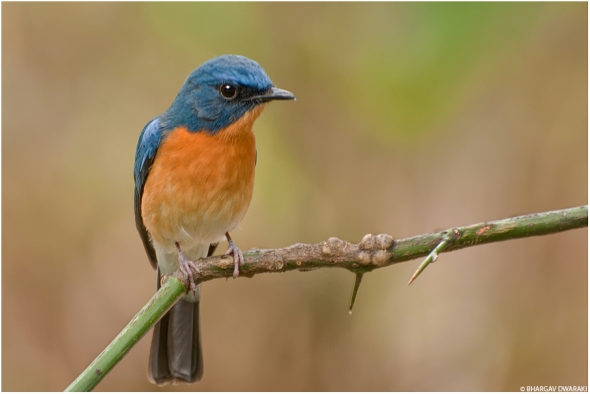 Tickell’s Blue Flycatcher
Tickell’s Blue Flycatcher
Male has the upper parts indigo blue and their forehead,supercilium and shoulders are azure blue , the throat and breast are orange – rufous and has white belly.Females are similar to male but are duller in color.
 Tickell’s Blue Flycatcher
Tickell’s Blue Flycatcher
They feed mainly by capturing insects in flight but their prey include other insects such as termites and earwigs that may be gleaned or picked from the ground.They have an unmistakable call which sounds tick – tick.( Source – Wikipedia and Handbook of the birds of India and Pakistan)
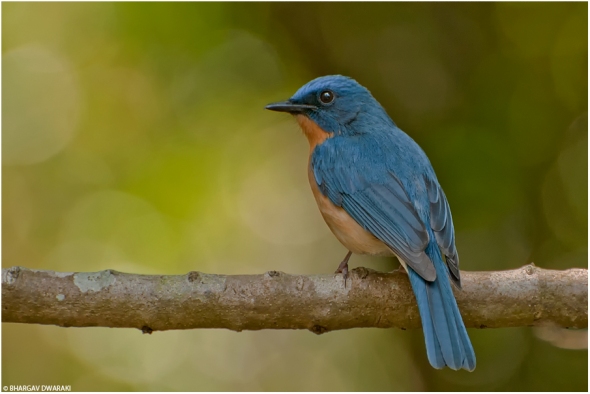 Tickell’s Blue Flycatcher
Tickell’s Blue Flycatcher
All 3 photos were taken in Nandi hills using Nikon D300s ,Nikkor 70 – 300mm VR lens.
Comments ,critics and suggestions are welcome 🙂
In the past 3 months I have made many visits to Nandi Hills and I Have struggled to photograph here because of the tricky light condition . Out of several visits I have made , only the last two were good in terms of photography and I learnt how to handle the camera in such condition.There is so much to learn!!And I am learning (slowly though). Saying that , every time I go to Nandi Hills I have a surprise waiting there each time. During each visit I get to see and learn something new , the last one being sighting of Pied Trush (Zoothera wardii) 🙂 . I really hope this continues 🙂
On a personnel note , I completed 23 years few days back and also completed 1.5 years in office. Office is frustrating like never before I think I was confident of doing something (in life) when I was jobless and sitting at home than now (while working). Hope things get better(Soon , Plz!!).
Cheers,
Bhargav
2012
2012 has been good. I bought my first Camera in August and have been doing quite well . When I started photography,I would just push the shutter button many times when I saw something, hoping that one would come out good. Now I use a more calculated approach, lots left to learn though .
I met some amazing people and made some good friends . I haven’t traveled and trekked ,as much as I wanted to but will make up for it this year 🙂
Well, 2012 has been the best year of my life so far. I hope 2013 gets better than that 🙂
Happy new year people , Thanks for the support .Have a great year ahead 🙂
 Happy 2013:)
Happy 2013:)
Common Kestrel (Falco tinnunculus) – Female
The Common Kestrel (Falco tinnunculus) is a bird of prey species belonging to the kestrel group of the falcon family Falconidae.It is a bird of farm land and open areas. It is known for the way it hovers above the ground , in search of prey.
It is a medium- sized (32- 29 cm ) falcon with long wings and tail.Plumage is light chestnut – brown with blackish spots on the upper-side and buff with narrow blackish streaks on the underside.The sexes are distinct, in males the rump and tail are bluish grey and unbarred,whereas in females they are brownish – red with dark barring.The head is grey in males and brown in females.( Source – Wikipedia)
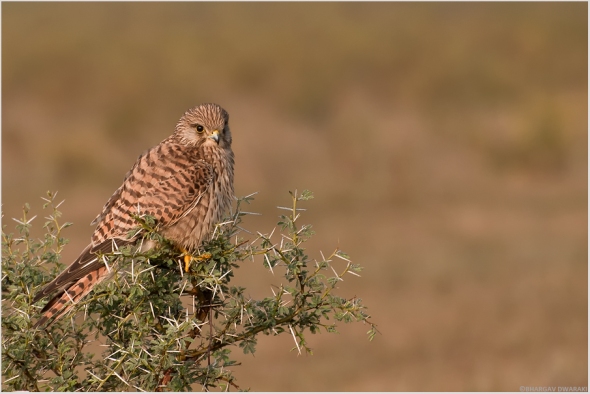 Common Kestrel
Common Kestrel
10th November, was a good day for me. Prior to this , I have tried almost a month to photograph this lady. Though I had managed to take few shots,I was not happy with it. On this day, I spent a good amount of time with her, I saw her Hoover , I saw her preen , I saw her catch insects. I managed to click shots which I wanted.
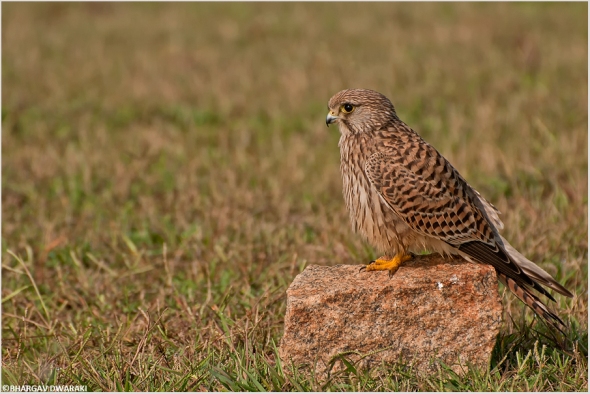 Ground Level shot of Common Kestrel
Ground Level shot of Common Kestrel
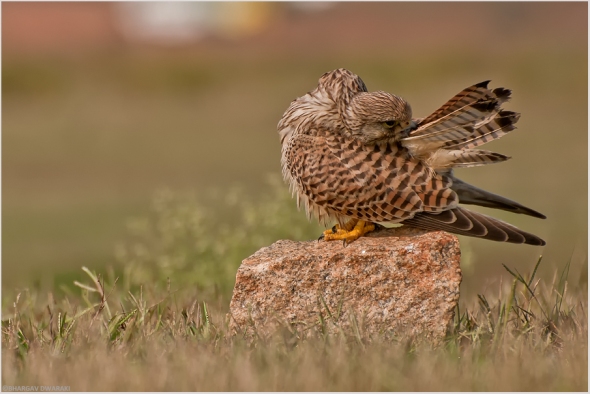 Common Kestrel – Preening
Common Kestrel – Preening
Please click HERE to read about Preening.
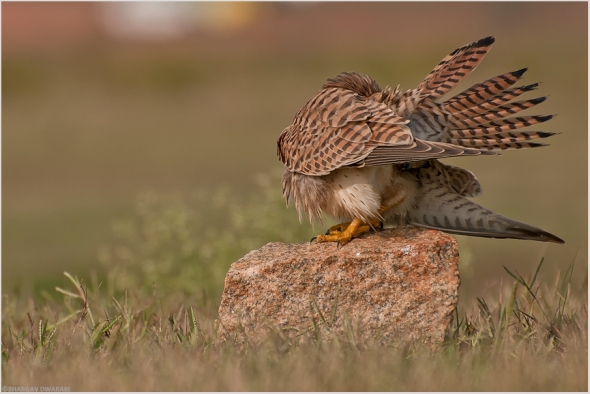 Lost in Preening
Lost in Preening
(Can you spot the head?)
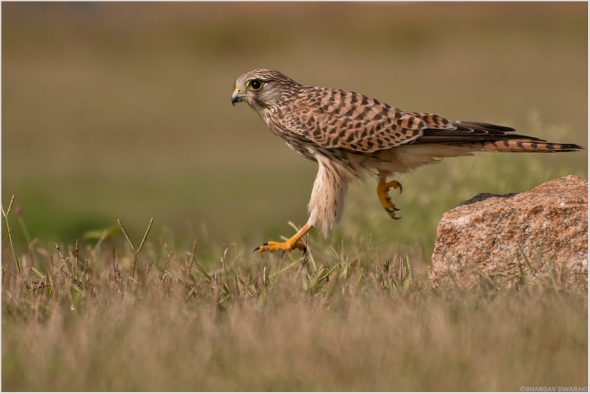 Jumping Kestrel
Jumping Kestrel
The below image was taken on 1st November and it is special to me. It was raining here in Bangalore for almost a week (remember Cyclone Nilam?), I had no plans of going for birdwatching or for photography as I thought it would rain , My friend (Hemanth) called me the previous night and asked if we can go, if there is no rain. On this day, it was drizzling but we thought it would stop and went ahead with the plan . But , the drizzle slowly picked up for our bad, added to that going in activa made it even more difficult for us. Mud went inside all possible parts it could go to and we had tough time cleaning it. It was still drizzling and was impossible to go back in the same path , we planned to take the other exit . On the way to exit , we stopped to take a photograph of a Paddy field Pipit but to our luck this beauty came and perched close to where we were.It was first time I was that close to any bird , I could see the details of it just with my eyes. I still cannot forget that eye contact. Got my first Portrait this day ! .Sometimes things just happen 🙂

A Portrait
The Kestrel feeds largely on small mammals, and small birds.Invertebrates are also very important components of the diet.Kestrels hunt by sight,upon spotting their quarry,they plunge to the ground ,seizing the prey with their talon.(Source – Arkive)
Kestrels, when hovering are able to stay still even in strong winds. I have seen one on top of Tadiyandamol hover against strong winds.
Nikon D300s,Nikkor 70-300mm VR lens , in Hessarghatta.
Hope you all had a great weekend ,Good Night 🙂
Egyptian Vulture (Neophron percnopterus)

Egyptian Vulture (Neophron percnopterus),also called the scavenger vulture. It has an unmistakable appearance, possessing white plumage with black feathers in the wings and tail . They have bare yellow face and the bill is large and narrow with a curved tip. The legs are pink in adults and grey in juveniles.Young birds are blackish or chocolate-brown with black and white patches.
 Egyptian
Egyptian
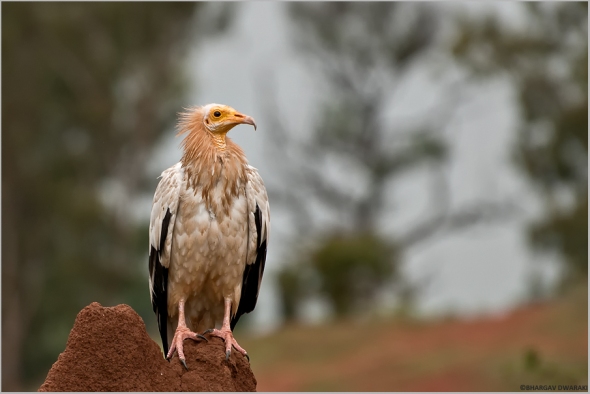
They are also called as Pharaoh’s Chicken
Egyptian Vultures feed mainly on carrion but are opportunistic and will prey on small mammals, birds, and reptiles.
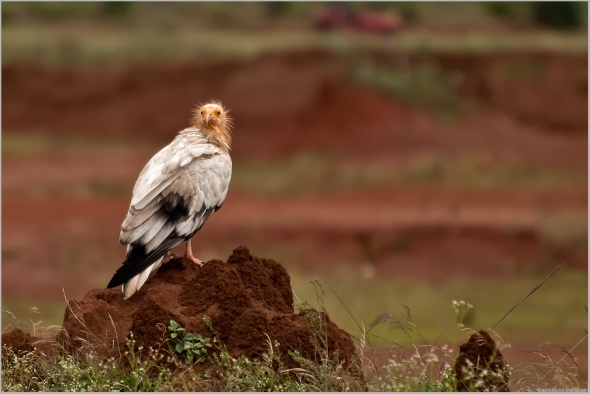
Conservation status of Egyptian Vulture is ENDANGERED , according to IUCN Red List.
The light was not on my side , this is the best I could do. Hope you like it.
Critics and comments are welcome 🙂
Light & Moss

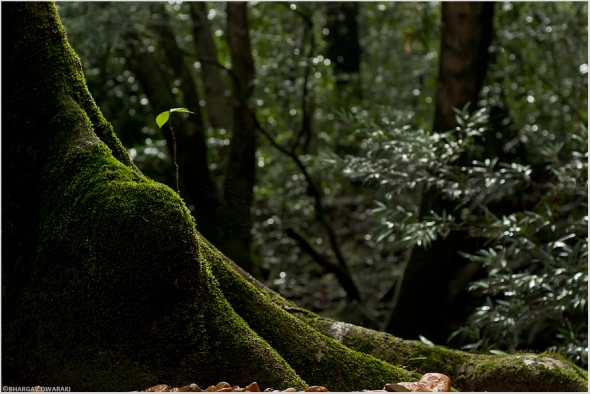 Light & Moss
Light & Moss
Mosses are small,soft plants .They commonly grow close together in clumps or mats in damp or shady locations.They do not have flowers or seeds,and their simple leaves cover the thin wiry stems.( Source – Wikipedia )
This picture also shows the lighting in Forest floor. The forest floor is usually shaded ,except where a canopy tree has fallen and created an opening. A small percentage of light that strikes the top of the forest penetrates to the forest floor.
Here, the moss is grown on buttress of tree. Will write more about buttress and canopy in coming posts 🙂
Taken in Agumbe , with Nikon D300s and my friends Nikkor 18- 55mm VR .
Cheers,
Bhargav
Common Kingfisher (Alcedo atthis)

Remember What a Day?? (click HERE ,if you don’t! ). It happened on that day(and on last weekend) .
Birds are very good posers, but unfortunately only for those who sit inside a car and click. For someone like me (who is on foot most of the time), they spot you before you see them and fly off. Having said that, I won’t complain. Its fun this way and I enjoy every bit of it.
Common Kingfisher is one of the many colorful and beautiful birds which every photographer likes to have a shot in his collection.Till this day, though I had seen it many times, I didn’t have even one good shot of this for some reason.
It was a lovely morning, I was walking on the bank of a small pond which is few km from my house, I noticed the Common Kingfisher perched on a small plant, looking for fish. Before I could do anything else it flew off from there (one more chance missed) and perched on a small distant twig. I decided to walk around the bush and stopped at a safe distance from the twig. I waited there for a while and let off few frames. From there, the bird was too small in my lens. Lying flat on the ground, I crawled slowly towards the bird. Slowly the bird started looking big (definitely not full frame) in my lens. It’s not that bird didn’t notice me, but it was probably preoccupied looking for fish.
I stopped at a comfortable distance and spent a lot time in front of it. It was worth every minute, I saw it look for the fish patiently, dive into water (they are avid divers), scaring the other Kingfisher which came towards it, catch and miss fishes, shaking the water off its body. This process kept on repeating. So amazing was the experience that though I missed many shots, I managed to take some decent ones in the end.
Let me introduce you to the bird itself,
Common Kingfisher (Alcedo atthis) is one of the most colorful and instantly recognizable birds. The upper parts are blue while the underparts are orange in color.The bill is very – long and dagger like. The Kingfisher feeds mainly on fish and invertebrates, which it catches by perching on a convenient branch. They usually sit on low-hanging branches or bushes right above the water or on small plants that spring up in the middle of shallow waters and dive into the water when prey comes within striking distance.
One strong Kingfisher:)
Well, its not about to fly or its not calling!! If you look at it carefully, there is one more Kingfisher flying towards it. This screamed and scared the other ‘fisher. This is not that good a pic, but I have put it here to show this behavior!!(how I wish the water didn’t reflect the white sky!).
This is how they look for fish.
As I mentioned earlier, Kingfishers are avid divers. After a dip into the lake and catching its prey, this is how they shiver the excess water off its body and batter the fish. This is my FAVORITE pic. For me, this represents the bird.
Click HERE to see color version of this.
On the way back home, though I wished I had an extra 100mm (which I can only wish for now 😦 ), I had a rare smile on my face. It is not often that things happen the way the you want and when they do happen, you should completely enjoy it!
Nikon D300s,Nikkor 70 – 300 mm lens, lying flat on ground.
Have a great Sunday.
The Rising Star

As I had told before,I trekked Tadiyandamol last weekend.Tadiyandamol, located at an elevation of 1,748 m (5,735 ft) is the highest mountain of Kodagu district,Karnataka and is also the 3rd highest peak in Karnataka.It is on the Western Ghats range and has patches of shola forests in the valleys.
Tadiyandamol is one of the easiest trek I have done so far and one of the beautiful places I have been.
Rising Star
Morning was extremely windy,I was literally carried away by the wind (now,that’s too much :P) but it was worth every minute .It was amazing to see the clouds envelop the landscape.
I spotted Plum headed Parakeet,Shrike,Bulbul’s ,Wagtail and oriental magpie Robin in the lower range and what’s worth mentioning is Common Kestrel .Saw this at the top most point , it was amazing to see it hovering against strong winds.
Hope you like it .Comments, critiques and suggestions are welcome.
Note: The last pic is not from Tadiyandamol.
Eurasian Roller (Coracias garrulous)

Eurasian Roller ( Coracias garrulous) also known as European rollers ,are migrants to our country and are near threatened species. They have colorful plumage .The head ,neck and underparts are light blue,while the upper parts are brownish -orange.A short ,thin black stripe runs through the eye.The tail is greenish- blue with a darker base.
Nikon D300s,Nikkor 70-300mm VR, f6.3,1/1000sec,ISO 400.
It feeds on invertebrates such as beetles, crickets, locusts, caterpillars, flies and spiders.
Nikon D300s,Nikkor 70-300mm VR, f6.3,1/800sec,ISO 400.
I first spotted this beautiful bird a day before this picture was shot but couldn’t capture the shot as too many people came in and frightened the bird away with all the activity 😦 . Luckily ,the very next day this bird flew to the place we were waiting .All we had to do was, just position our self at comfortable distance and click .
 Nikon D300s,Nikkor 70-300mm VR, f6.3,1/800sec,ISO 400.
Nikon D300s,Nikkor 70-300mm VR, f6.3,1/800sec,ISO 400.
Hope you like it 🙂
Meanwhile ,I trekked Tadiyandamol (Highest peak in Coorg range also 3rd highest peak in Karnataka) last weekend. It was brilliant, caught some good shots,will post them soon.
Have a nice day 🙂
Paddyfield Pipit (Anthus rufulus)

Paddyfield Pipit (Anthus rufulus) is a small(15cm) passerine bird, the upper plumage is mainly streaked in grey brown with patches of black.It is long-legged with a long tail and a long beak.The iris and bill is brown,legs are of flesh color.
Nikon D300s,Nikkor 70-300mm VR, f6.3,1/1250sec,ISO 250,Hessarghatta.
It is seen in open habitats, such as bare grounds or grasslands, short crop cultivated lands etc.
Nikon D300s,Nikkor 70-300mm VR, f6.3,1/1600sec,ISO 250,Hessarghatta.
Its call is “chip-chip-chip”, It feeds principally on small insects but consumes larger beetles, tiny snails, worms etc.(Credit – Wikipedia)
Good Night 🙂
Pied Bushchat (Saxicola caprata ) Female

Here is another post on Pied Bushchat Saxicola caprata, but this time its Female. For details and earlier post please click Here.
Have a good day.
Cheers,
Bhargav
Siberian Stonechat (Saxicola maurus ) Female

The Siberian Stonechat or Common Stonechat is a resident and a winter visitor to India.The Siberian Stonechat is insectivorous.It breeds in open rough scrub-land or rough grassland with scattered shrubs.The female has pale brown upper parts and head, white neck patches (not a full collar), and a pale, unstreaked pinkish-yellow rump.
All images shot with Nikon D300s,Nikkor 70-300mm VR. There was hardly anything behind the bird and hence,clean background.
Hope you liked it. Have a great Weekend .
Patterns 1

Patterns are present all around you ,all you need to do is recognize and enjoy them.
This was on last sunday morning trip to Hessarghatta. We (myself ,Dr Shekar and his friend Shivkumar) reached the place around 6.30 in the morning but to our bad luck it started raining and it poured heavily for a while. After the rain stopped (around 8.30 ), we had some good sightings among which Short toed Snake Eagle, Marsh Harrier, Common Kestrel were first timers for me. Got few good shots,will post it soon.
Can you guess what are these ?
Its a very easy guess. Let me know what you think. I will answer in my next post (am sure you will guess before that!)
Black Kite (Milvus milgrans)

Black Kite ( Milvus milgrans ) is a medium-sized common raptor and a widespread resident in India,often found around human habitation.They are distinguished by their forked tail and call.They can be seen soaring and gliding in thermals in search of food.
They are more scavengers than hunters.Other birds are often chased away by mobbing Black kites (I have seen them attack Indian Roller and Common Kestrel).
Here is the link for my earlier post on Black kite.
All comments, critiques and suggestions are welcome.
Passion Flower (Passiflora foetida)

Passion flower ,kukkiballi(kannada) or love in a mist is a commonly seen weed flower from Central America.
The flower are white to pale cream coloured, about 5–6 cm diameter, It is able to trap insects on its bracts, which exude a sticky substance that also has digestive enzymes. This minimizes predation on young flowers and fruits.It is currently considered as protocarnivorous plant.(Refference – Wikipedia)
Common jezebel (Again)

Hi ,
I had posted a photo of Common jezebel earlier (here is the link if you haven’t seen ) but I am too tempted to post the photos of this beautiful butterfly which I took last month, in Hebbal.
Hope you like it.
 Black and White – A perspective
Black and White – A perspective
For details please see my earlier post (click here)
All comments, critiques and suggestions are welcome.
Ashy-crowned Sparrow Lark (Male) (Eremopterix grisea)

Ashy – crowned Sparrow Lark (Eremopterix griseus) is a lovely, small bird (12cm) about the size of sparrow.It is also known as Ashy – crowned Finch Lark or Black-bellied Finch-Lark.It is a bird of open dry habitat.The males are marked with a contrasting black and white face pattern,females are sandy brown.
Photo Of The Day – Egret about to take Off

Egret’s are one of the best subjects to learn new techniques in photography as they can be easily spotted and with little patience ,one can approach and move closer to them. I have applied ND filter while converting into Black n White , Shot with Nikon D300s ,Nikkor 70-300mm VR , in Shanthigrama.
I have applied ND filter while converting into Black n White , Shot with Nikon D300s ,Nikkor 70-300mm VR , in Shanthigrama.
Hope you liked it .
Good night 🙂
Spotted Dove(Spilopelia chinensis)

Spotted Dove (Spilopelia chinensis) is one of the most common species of dove found across India.It is pinkish brown bird with grey upper parts with a typical black and white spotted patch on their nape are very shy and peace-loving birds.
 Spotted Dove
Spotted Dove
What A day !!!!

With salary still not being Credited (which means little or no money left with me ), I had only one place to choose for this weekend, that is my house in Shathigrama. And to my luck?? It was a good a choice.
I left Bangalore around 9pm on Friday,reached here around 2 Am on Saturday morning!!! ( Thanks to the rains and long break in between) . Saturday morning was gone as I got up really late (especially for bird watching 😦 ) , evening session was good, I got a good shots of Pied Kingfisher, Common Kingfisher . Today was the best day , here goes the bird list for the day
Green bee eater ( I don’t know if this likes me but I see this whenever I come here, saw this yesterday too 🙂 ),Pied KF , Common KF ,White cheeked barbet ,Indian peafowl,Pheasant tailed jacana,Black headed munia,Scaly breasted munia,Baya weaver bird,Flame back woodpecker ( Couldn’t see properly but have a record shot ),Little cormorant,Yellow billed babbler,Red whiskered bulbul,Red vented bulbul,Ashy prinia,Spotted Dove,Laughing Dove,Brahminy kite,Egret,Painted Stork,Black Winged Stilt ,Red wattled lapwing ,Purple Swamphen,Common coot,Ibis and lot of other birds.
I was truly spoilt for choice as I did not know what to click, couldn’t get the shot of everything I saw, but made few good images .
GOOD NEWS – My father , who was not that happy with me going around with camera has started liking my photos. He had even arranged a vehicle for me to go around the village :).
After this he said , if you had shown half the interest which you are showing towards this , you would have finished Engineering with DISTINCTION!!!! (Its been almost a year since I passed of BE but he is still thinking about my BE percentage 🙂 )
Photo Of The Day – Common Jezebel

The Common Jezebel (Delias eucharis) is a medium-sized pierid butterfly, it has a wingspan of 66 -83 mm . The white and yellow butterfly is active throughout the year and is found in almost all kinds of habitats (except very thick wet evergreen forests and grasslands) . It is among the most prominent butterflies to visit city parks and gardens and is most active during noontime & afternoons.
It flies fast and flies high in the canopy and can travel long distances.It prefers to be in the canopy except when it is feeding on flowers of shrubs . Its is protected from predators by unpalatable alkaloids in its body. It flies in a leisurely manner and it basks (with their wings closed) and sleeps on the overhanging branches of tall trees.
( Reference –Wikipedia , Butterflies of Peninsular India by Krushnamegh Kunte )
Please click on the image to see full view.There is one more shot of this ( please click here ) , but I liked the one displayed above. Let me know which one you like.
Nikon D300S with Nikkor 70 -300 mm VR, in Hebbal lake , Banglore.
Common Langur / Gray Langur

Common / Gray langurs or Hanuman langurs, the most widespread residents of Indian forests, are a group of old world monkeys constituting the entirety of the genus Semnopithecus.
It was in Bandipur, around 4’o clock in the evening and our safari was scheduled around 5 pm, having an hours time , I decided to walk around and look for some birds around the reception area. I spotted a group of Common/ Gray Langurs and spotted deers and made a few decent images of langur’s.
Monkey’s and Elephant’s are my favorite subjects to photograph. You wont get bored with it, even if you sit in front of it for days together.
I have taken photos of the mother looking at the baby , baby playing with mother , which are all quite common but I chose this image for back-lit effect on mother face and of course baby. The mother initially didn’t allow me closer to it, it used run away from but then I sat in front of it for almost half an hour and then I could go little closer to it. This baby was a naughty one and did all sorts of faces to me 😛
Evening lights are beautiful, sometimes I feel that ,its important to photograph the light on the subject than the subject.
Gray Langur monkey’s have superior eyesight and ability to sit atop high trees which allows it to spot predators easily.It is also known as cheetal deer’s best friend.
Please click on pictures to see full view. All photos taken with Nikon D40 with 70 -300 lens, manual focus , in Bandipur national park.
Good night folks 🙂
